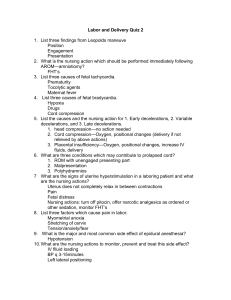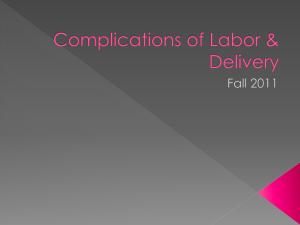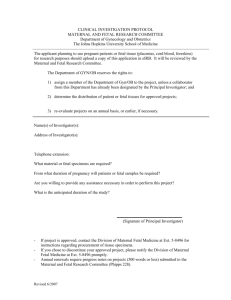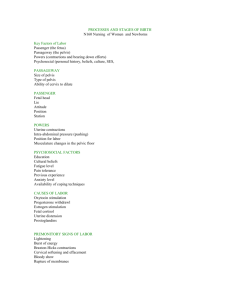Nursing Care - wcunurs206and216
advertisement
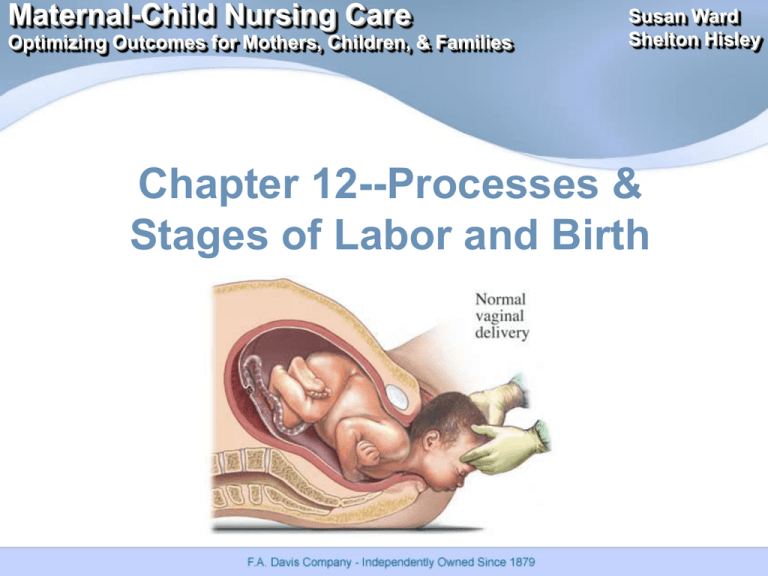
Maternal-Child Nursing Care Optimizing Outcomes for Mothers, Children, & Families Susan Ward Shelton Hisley Chapter 12--Processes & Stages of Labor and Birth Critical Factors In Labor The Four P’s: passage, passenger, powers & psyche Passage: adequate pelvis? cephalopelvic disproportion (CPD) Suspect if presenting part does not engage in pelvis (0 station) Passenger The fetus: head is largest diameter Fetal head: 4 bones with 3 membranous interspaces (sutures) that allow bones to move & overlap to diminish size of skull Molding: head becomes narrower, longer, sutures can overlap--normal--resolves 1-2 days after birth Fontanelles: at junctures of skull bones Passenger Fetus and fetal membranes Molding of head Fetal lie Longitudinal Transverse Oblique Fetal Lie and Presentation Leopold's maneuvers/US Longitudinal lie: Vertical Presenting part: cephalic (head), vertex (occiput), chin (mentum) breech (buttocks or feet) (c-section) sacrum Transverse lie: Horizontal (c-section) Presenting part: shoulder (acromion) Passenger (cont.) Fetal attitude—flexion Fetal presentation Cephalic Vertex Military Brow Face Fetal Attitude Advantages of Cephalic Presentations Head usually largest part of infant Molding Optimal shape—smooth and round Breech presentation Assessment: FHT heard high on the abdomen, Leopold’s, vaginal exam & US. Higher risk of anoxia from prolapsed cord, traumatic injury to the after coming head, fracture of spine or arm, dysfunctional labor Usually delivered by C-section Disadvantages of Breech Presentation Risk of cord prolapse Presenting part less effective in cervical dilation Risk of cord compression Risk of prolonged labor Shoulder Presentation Occurs when fetus in transverse lie Cannot be delivered vaginally unless rotation occurs IMPORTANT TERMS Effacement: shortening and thinning of cervix Expressed as a percentage (0% to 100%) Dilation: opening and enlargement of cervix Expressed in centimeters (1 to 10 cm) Effacement Thinning of cervix (in %) Station Descent of fetal head (in cm) Descent of fetal head: Station Floating Engaged At outlet/crowning Passageway + Passenger Relationship Engagement Station Ischial spines—0 station Above ischial spines—(–) minus station Below ischial spines—(+) plus station +4 cm means that ... Powers Uterine contractions—primary force Maternal pushing efforts—secondary force Characteristics of uterine contractions Increment Acme Decrement Powers Maternal Pushing Efforts “Bearing down” sensation Urge to push No urge to push Assessment of Uterine Contractions Characteristics Frequency Duration Intensity Palpation Electronic fetal monitoring Onset of labor Usually begins between 38 & 42 weeks Mechanism is unknown Upper uterus contracts downward pushing presenting part on cervix causing effacement and dilatation Premonitory signs of labor: Lightening, Braxton-Hicks contractions (false labor), cervical changes (ripening), bloody show (mucous plug), rupture of membranes (ROM), sudden burst of energy False vs True Labor: Contractions False Labor Benign and irregular contractions Felt first abdominally and remain confined to the abdomen and groin Often disappear with ambulation and sleep. Do not increase in duration, frequency or intensity True Labor: Begin irregularly but become regular and predictable Felt first in lower back and sweep around to the abdomen in a wave Continue no matter what the women’s level of activity Increase in duration, frequency, and intensity False vs True Labor: Cervix False Labor True Labor No significant change in dilation or effacement Progressive change in dilation and effacement No significant bloody show Bloody show Fetus- presenting part is not engaged in pelvis Presenting part engages in pelvis Critical Thinking A primigravida client has just arrived in the birthing unit. What steps would be most important for the nurse to perform to gain an understanding of the physical status of the client and her fetus? A. Check for ruptured membranes, and apply a fetal scalp electrode B. Auscultate the fetal heart rate between and during contractions C. Palpate contractions and resting uterine tone D. Perform a vaginal exam for cervical dilation, and perform Leopold's maneuvers E. Determine gestational age of fetus First Stage of Labor: 0 to 10 cm: dilatation--opening of cervix) Latent: slowest part of the process--slow dilation, mild contractions from onset of regular UCs to rapid dilatation (about 3-4 cms) Active: labor “picks up steam”--period of more rapid dilation from 4 cm to full dilatation: stronger UCs Transition: 7-10 cm--intense, N/V, shaking Landmarks Abbreviations are used First and last letter—maternal pelvis Middle letter—fetus presenting part Examples ROA (right occiput anterior) ROP LSP Psychosocial Influences Other critical factors Readiness, educational preparedness, etc. Cultural views of childbirth Role transition facilitated by positive childbirth experience Negative experience interferes with bonding and maternal role attainment Childbirth Settings and Labor Support Admission Procedures Establish positive relationship Collect admission data Initial admission assessments Focused Psychosocial assessment Cultural assessment Laboratory tests Nursing Care Ongoing assessment Facilitate a positive birth experience Manage discomfort Advocate for patient’s needs Provide anticipatory guidance Care of Laboring Patient Early Labor Couple excited, talkative, pain is manageable Initial physical assessment & history Admission--rapport Fetal & UC monitoring Vaginal exams, q 2 hours Vital signs Temperature q 4 hours-intact or q 2 hours ROM Educate regarding labor Encourage comfort, position changes, bladder emptying Assess pain, pain tolerance, preferred type of labor/delivery Reassure regarding what is normal, reduce anxiety Care of Laboring Patient Active Labor Couple quieter, discouraged, pain increasing Transition (7-10 cm): Yikes! “out of control”, shaking, nausea/vomiting, sweating, pain is intense Prepare for delivery Second stage (Pushing): Educate/instruct regarding pushing Assess urge to push and fetal descent Encourage/motivate patient, assess fatigue Monitor fetal/maternal response to pushing bulge, crowning Signs of imminent birth: perineal bulging Labor Support Presence Promote comfort Environment Personal hygiene Elimination Supportive relaxation techniques Critical Thinking A client is admitted to the labor unit with contractions 2 to 3 minutes apart and lasting 60 to 90 seconds. The client is apprehensive and vomiting. This nurse understands this information to indicate that the client is most likely in what phase of labor? A) Active B) Transition C) Latent D) Second Fetal Assessment Position Fetal heart sounds Baseline FHR Presence of Variability Accelerations Decelerations Interpretation of FHR Tracings Consider contraction frequency and intensity, stage of labor, and earlier FHR pattern Reassuring Non-reassuring Nursing Care FHR decelerations Early: no action Variable and late Lateral position changes Oxygen per face mask Palpation for hyperstimulation Discontinue oxytocin Increase IVF rate Second Stage of Labor Full dilation through birth of infant Urge to push Promote effective pushing Closed-glottis Open-glottis Position of comfort Preparation for Birth Bulging of the perineum and rectum Flattening and thinning of the perineum Increased bloody show Labia begin to separate Dilatation & Effacement Imminent Birth Crowning Burning sensation Intense pressure in rectum Mechanisms of labor. A, Descent. B, Flexion. C, Internal rotation. D, Extension. E, External rotation. Cardinal Movements of Birth Head Rotation during Descent Crowning Crowning Alternative settings In the hospital Nursing Diagnoses for Intrapartal Patient Pain Knowledge deficit Anxiety Fatigue Risk for infection Impaired fetal gas exchange Third Stage Birth of baby to complete delivery of placenta Smaller, spherical uterus Elevation of uterus in abdomen Lengthening and protrusion of cord Gush of blood from vagina Fourth Stage Delivery of placenta through 1 to 2 hours after birth Monitor position and firmness of uterus “Boggy,” soft uterus Report immediately Initiate fundal massage Assess lochia Vital signs and urine output Shivering—offer blankets Fourth Stage —Risk Signs Hypotension Tachycardia Excessive bleeding Noncontracting uterus Maternal-Child Nursing Care Optimizing Outcomes for Mothers, Children, & Families Susan Ward Shelton Hisley Chapter 13 Promoting Patient Comfort During Labor and Birth Pain During Labor and Birth Shaped by past experiences Assessing pain Physiological, psychological indicators Patient responses May be intensified by fear, anxiety, fatigue Maternal-Child Nursing Care Optimizing Outcomes for Mothers, Children, & Families Physical Causes of Pain Labor and Birth Susan Ward Shelton Hisley Pain Neurology Uterine ischemia Visceral pain—dull and aching Referred pain Somatic pain—sharp, burning, prickling Pain Perception and Expression Highly personal and subjective Affected by gender, culture, ethnicity, and past experiences Physiological/affective expression Increased catecholamines Increased blood pressure and heart rate Altered respiratory pattern Factors Affecting Maternal Pain Response Physical Physiological Psychological Anxiety, fear, previous experience Support systems, childbirth preparation Environmental Nonpharmacological Pain Relief Measures Maternal position and movement Breathing techniques Music Relaxation techniques Other attention-focusing strategies Guided imagery Massage and Touch Effleurage Counterpressure Therapeutic touch Healing touch Other Therapies for Comfort Hydrotherapy, hypnotherapy, aromatherapy Application of heat and cold Biofeedback, TENS, intradermal water block Acupressure/acupuncture Pharmacological Pain Relief Measures Timing Nonpharmacological and pharmacological measures promote positive experience Informed consent Pharmacological Measures Sedatives and antiemetics Systemic opiods & analgesics Nerve Block Analgesia, Anesthesia Regional anesthesia- Epidural Local perineal infiltration anesthesia Pudendal nerve block Spinal anesthesia block Complications: maternal hypotension, decreased placental perfusion, ineffective breathing pattern Systemic Analgesia Pre-medication Assessment: Pain level, VS, allergies, drug dependence (withdrawal), vaginal exam/progress in labor, UC pattern, fetal heart rate tracing Post-medication Assessment: VS, esp. RR, LOC, dizziness (bedpan), sedation, FHR Reversal agent: Naloxone (Narcan) Competes with narcotic for opiate receptors. Used in both mom and baby. (avoid with narcotic dependence) Regional Anesthesia Definition: Injection of local anesthesia to block specific nerve pathways • Epidural/spinal anesthesia • Systemic toxicity: cardiovascular collapse • Side effects: Hypotension (preload with IV fluids), fetal distress on FHR tracing, spinal HA • Contraindications: coagulation disorders, low platelet count (< 100), allergy, neurologic disease, aspirin or heparin use Nursing care: Preload IV fluids (LR), monitor BP, HR, anesthesia level, FHR, foley catheter, maternal positioning Maternal Hypotension Prevention Preload IV fluids Requires constant nursing attendance Monitor vital signs Epidural Anesthesia Postdural Puncture (Spinal) Headache Leakage of cerebrospinal fluid Intensified in upright position Auditory and visual problems Autologous epidural blood patch Discharge instructions Disadvantages of Epidural Limited mobility Common side effects Accidental injection into blood vessel Sympathetic blockage Urinary retention, bladder distention General Anesthesia Major risks –used ONLY in emergencies Pre-operative preparation Anesthetic gases and medications Recovery room nursing care Nursing Care Related to Comfort Measures Assessment Ongoing and collaborative Diagnoses Anxiety Ineffective coping Acute pain Nursing Care Expected outcomes Plan of care Individualized Modified as needed Collaborative approach Maternal-Child Nursing Care Optimizing Outcomes for Mothers, Children, & Families Chapter 14 Caring for the Woman Experiencing Complications During Labor and Birth Susan Ward Shelton Hisley Dystocia Long, difficult, or abnormal labor May arise from Powers Passenger Passageway Dysfunctional Labor Pattern: Hypertonic Strong, painful, ineffective contractions Contributing factor—maternal anxiety Occiput-posterior malposition of fetus Management Rest, hydration, sedation Facilitate rotation of the fetal head Dysfunctional Labor Pattern: Hypotonic Contractions decrease in frequency and intensity Maternal and fetal factors that produce excessive uterine stretching Management Walking, position changes Augmentation of labor Precipitate Labor and Birth Rapid labor & birth Nursing considerations Careful examination for dilation and effacement Reassure woman and support person Breathing to avoid pushing and prevent tearing Careful examination of maternal soft tissue and placenta Pelvic Structure Alterations Pelvic dystocia Soft tissue dystocia Trial of labor To assess safety of vaginal birth Obstetric Interventions Amniotomy Artificial rupture of membranes Augment or induce labor Nursing Careful monitoring of vital signs, cervical effacement/dilation, station, FHR, contractions Document regarding amniotic fluid Obstetric Interventions Amnioinfusion Risks: infection, overdistention of uterus, increased uterine tone Nursing Careful monitoring of infusion, intensity and frequency of contractions, and maternal vital signs Educate Pharmacological induction of labor Nonpharmacological stimulants of labor Episiotomy Midline or mediolateral Nursing care: Assess for approximation, swelling, oozing, infection Relief for pain: ice pack in first 24 hours, then heat, local analgesic spray, witch hazel pads (Tucks), sitz bath, peri-bottle for voiding, pain medications Induction of Labor Indications for induction Bishop score Cervical ripening agents Mechanical methods Oxytocin Augmentation of labor Induction—Nursing Considerations Informed consent Careful monitoring of labor Discuss pain relief measures Position changes Keep patient and support person informed of progress Instrumentation Assistance of Birth Forceps Indications: unable to push, arrested descent, need a quick delivery, breech Associated with: maternal/fetal birth trauma, rectal sphincter tear, urinary stress incontinence Vacuum extraction Advantages: fewer lacerations, less anesthesia needed, Disadvantages: marked caput, cephalhematomas, scalp laceration/bruising Maternal Complications Hypertensive Disorders Preeclampsia-eclampsia, HELLP syndrome Nursing Careful assessments Monitor lab values Administer platelets as appropriate Ongoing education Maternal Complications Diabetes Fetal lung maturity Intrapartum management -Maternal hydration, -Insulin, and -Blood glucose levels Labor: normal progression of labor Upright or side-lying position Encourage breastfeeding Preterm Labor and Birth Careful maternal monitoring FHR monitoring *** Identify and report symptoms suggestive of fetal hypoxia Assess psychological status Labor and Birth Complications Fetal Fetal malpresentation Version: external or internal Shoulder dystocia Cephalopelvic disproportion Multiple gestation Non-reassuring FHR patterns Macrosomia/Shoulder Dystocia Wt. > 4500 gms (9-10 lbs) Associated with: DM, Gestational DM, Multiparity, Postdates, obesity Risks: Shoulder dystocia, difficulty delivering the shoulders after head is delivered (obstetrical emergency) Maternal: vaginal/cervical tears, pp hemorrhage, rupture Fetal: compressed cord, fractured clavical, asphyxia & neurologic damage, brachial plexus injury (Erb’sPalsy) S/S: Turtle sign Nursing interventions: McRoberts maneuvers, suprapubic pressure. PP: assess for uterine atony/hemorrhage; trauma, cerebral or neurologic damage to baby Video: youtube.com/watch?v=jV6g427UMxY&feature=related McRoberts Maneuvers Video Amniotic Fluid Complications Oligohydramnios Hydramnios Meconium Nuchal cord Other Complications Uterine rupture Obstetric emergency Uterine inversion Umbilical cord prolapse Maternal-Child Nursing Care Optimizing Outcomes for Mothers, Children, & Families Susan Ward Shelton Hisley Collaboration in Perinatal Emergencies Perinatal Fetal Loss What to say What NOT to say Nursing considerations < 20 weeks > 20 weeks name & hold the baby funeral/memorial service Resolve support group Cesarean Birth Indications Health of mother or fetus is jeopardized Ethical considerations Surgical procedures Surgical and postoperative care Vaginal birth after cesarean Cesarean Birth Indications for: Maternal Factors Placenta Factors Placenta previa Placental abruption Umbilical cord prolapse Active genital herpes AIDS/HIV + Cephalopelvic disproportion Severe preeclampsia, diabetes Obstructive tumor Ruptured uterus Previous c-section Failed induction/fx to progress in labor Elective? Fetal Factors Breech, transverse lie Macrosomia Extreme low birth wt Fetal distress Fetal anomalies Multiple gestation Maternal Complications Infection Anesthesia reactions DeepVeinThrombophebis Bleeding Ureteral/bladder injury Increase risk for subsequent pregnancy Placenta Acreta/Previa, Infertility Cesarean Birth (cont) Mortality/morbidity 4 x higher than vaginal birth in US. Most risk assoc. with emergency c-section Incision Skin vs. uterine Classical vs low transverse Postterm Pregnancy > 42 weeks Maternal risks: trauma/hemorrhage due to larger baby, ↑operative delivery/csection Fetal risks: placental changes that ↓oxygenation to baby and ↑mortality rate, oligohydramnios (↑cord compression during labor), LGA baby (↑birth trauma, shoulder dystocia), meconium aspiration Management: > 40 wks, NST, BPP or modified BPP (NST & AFI), induction Post-Op Care Assess fundus/bleeding, vital signs, DVT. Antibiotics, if infection Pain: Duramorph. Breakthrough pain meds. Benadryl for itching. Zofran for nausea. Clear liquids and advance as tolerated. Assess for GI function. Bowel sounds? Passing flatus? Ambulation. Pre-medicate, teach splinting with pillow. Critical Thinking A laboring multipara is having intense uterine contractions with incomplete uterine relaxation between contractions. Vaginal examinations reveal rapid cervical dilation and fetal descent. What should the nurse do first? A) Notify the physician of these findings. B) Place the woman in knee-chest position. C) Turn off the lights to make it easier for the woman to relax. D) Assemble supplies to prepare for birth. Case Study: Linda Mandella Linda Mandella is in labor with her third baby at the birth center. She wishes to experience a natural, unmedicated birth. Linda is groaning and crying. A cervical examination performed 2 hours ago revealed that she was 6 cm dilated, and 100% effaced. Linda’s family is present, and this is the first time that they have been able to attend and support her during the labor and birthing process. The family members are shouting and blaming the nurse for causing Linda to suffer. They demand that the nurse give Linda painkillers to ease her suffering and pain. Critical Thinking Questions 1. What are the priority nursing diagnoses at this time? 2. What are the expected outcomes associated with these diagnoses? 3. Describe the teaching/learning needs related to the scenario that correspond to the priority nursing diagnoses. 4. List nursing interventions with rationales that correspond to the priority nursing diagnoses.


